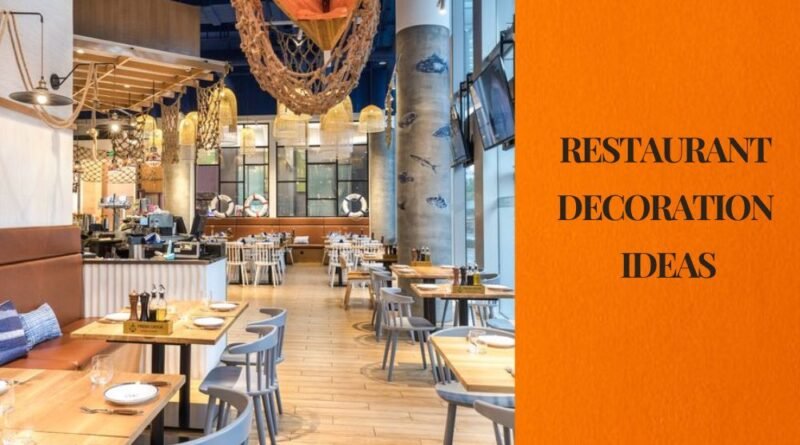10 Restaurant Decoration Ideas
If you want your guests to experience a truly immersive dining experience, let them indulge in more than just their taste buds. Create restaurant interior design that wows your customers while building brand recognition and loyalty.
A restaurant’s interior design should be an extension of its brand and allow it to make a powerful first impression. In fact, color alone can influence up to 90% of a guest’s perception.
Here are 10 restaurant decoration ideas to help you create an inviting space that reflects your vision.
Table of Contents
Restaurant Decoration Ideas
1. Let’s go green
Placing greens in the restaurant is one of the best restaurant decoration ideas that will enhance the ambiance.
You can decorate your venue with lots of greenery by adding indoor plants to the decor. Not only are plants beautiful and relaxing, but they can also help purify the air. They also help guests visualize the quality of the food you serve.
They’re enjoyable to look at, but they’re also proven mood boosters known to eliminate stress, and they can reduce air toxins by 87% in just 24 hours.
You can infuse green goodness into your restaurant by hanging plants from the ceiling, creating an entire wall, or placing plants on shelves.
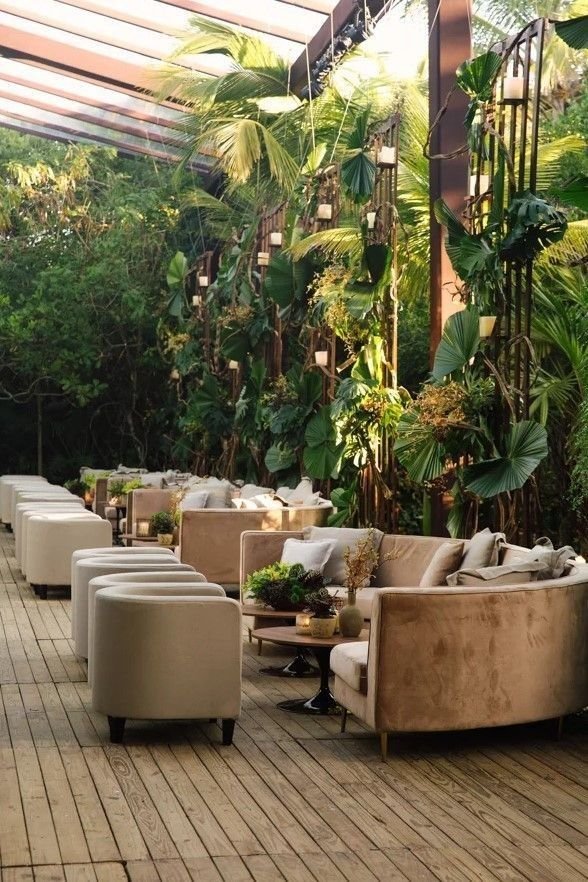
Ideas:
- Use local plants: Opt for native plants or those suited to your local climate to ensure they thrive.
- Vertical gardens: Install living walls or vertical gardens to maximize space and impact.
- Air purifying plants: Choose plants like peace lilies or snake plants known for their air-cleaning properties.
- Seasonal displays: Rotate plants and decorations according to seasons to keep the decor fresh and engaging.
- Educational signage: Include tags or plaques with plant names and benefits to educate guests.
Best Practices:
- Maintenance schedule: Implement a regular watering and pruning schedule to keep plants healthy.
- Lighting considerations: Ensure plants receive adequate light levels based on their species and placement.
- Plant selection: Research plant types that thrive indoors and complement your restaurant’s aesthetic.
- Air quality monitoring: Invest in air quality monitors to showcase the benefits of plant life to guests.
- Educational signage: Provide care tips for plants to encourage guests to replicate at home.
2. Support Local Artists
Portraying the artwork of local artists is one of the best restaurant wall decor ideas as they showcase your community’s talents, and generate conversation among guests and staff.
Moreover, the artwork of the local people is quite affordable and serves as one of the best low-budget restaurant interior design ideas for people who just started a new restaurant!
If you have open wall spaces in your restaurant, you can get help from local talents to beautify the walls with their artistic touch.
You can get a rotating collection of unique decor by featuring a new artist or group of artists each month or quarter, and local artists get a chance to sell their work.
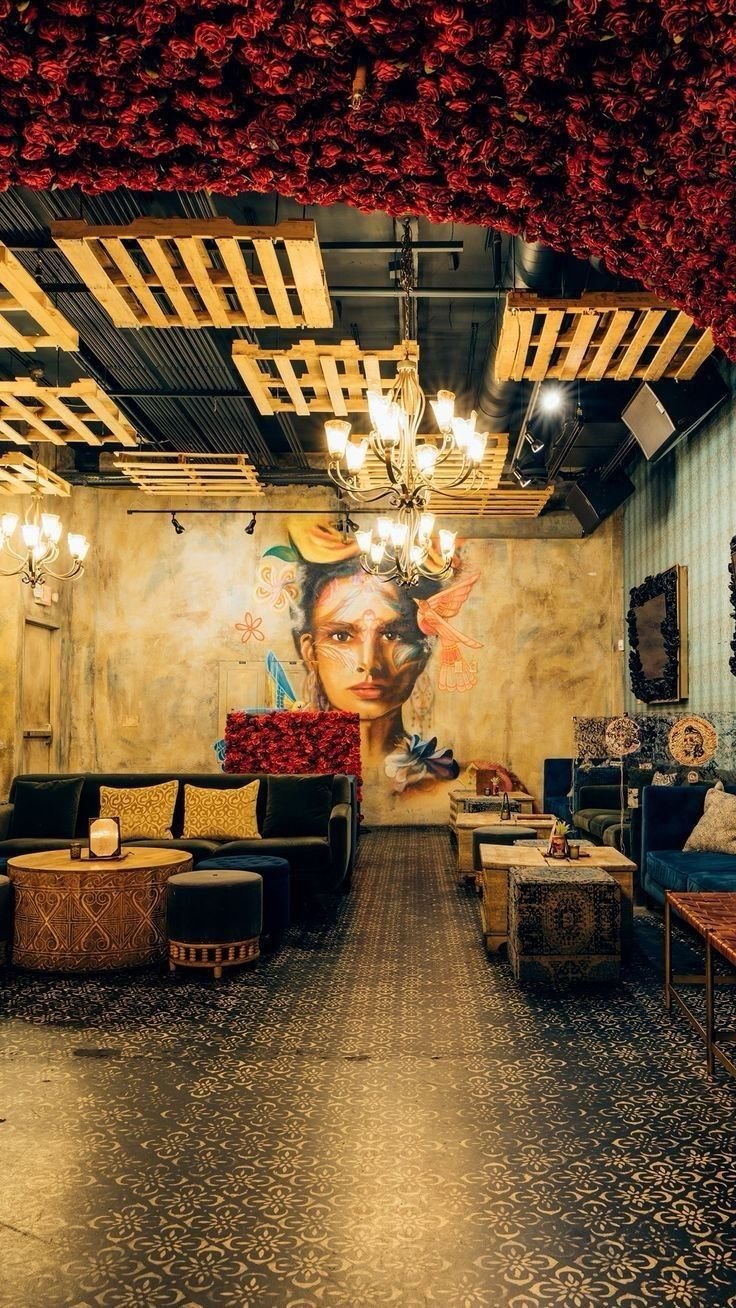
Ideas:
- Rotating exhibitions: Feature a new artist or group every month or season to keep the decor dynamic.
- Collaborate on events: Host art events or openings to showcase new artwork and engage the community.
- Artist profiles: Display artist bios and contact information alongside their works.
- Commissioned pieces: Invest in custom pieces that reflect your restaurant’s theme and values.
- Interactive displays: Incorporate QR codes or NFC tags for guests to learn more about displayed artworks.
Best Practices:
- Contract agreements: Establish clear agreements with artists regarding commissions, display periods, and sales.
- Promotional efforts: Market artist features on social media and in newsletters to maximize exposure.
- Gallery events: Host openings or artist meet-and-greets to foster community engagement.
- Sales support: Provide information on how guests can purchase displayed artwork or contact artists.
- Feedback loop: Gather guest feedback on displayed art to inform future artist selections.
3. Typography
Typography is one of the best restaurant decoration ideas to showcase your brand.
As in this typography mural at Malmö Restaurant in Valencia, Spain, which features the brand name alongside staple ingredients such as eggplant, mushrooms, and nuts, you can create an accent wall with your restaurant’s name.
When you implement this right, your decor will be a hit. Bold graphics, marquee letters, diagrams, and charts are all fun (and informative) ways to add detail to your design scheme.
You can also get an old-school neon sign made custom-made with a quote or phrase that reflects your restaurant’s vibe right now.
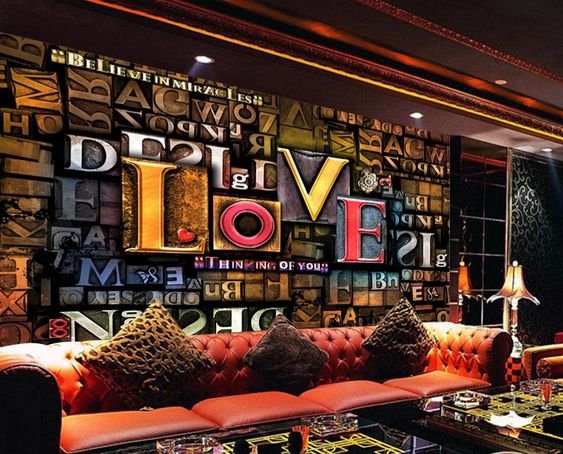
Ideas:
- Custom typography: Design unique signage or murals that incorporate your restaurant’s name and theme.
- Menu boards: Use creative typography for menus or special boards to enhance visual appeal.
- Historical quotes: Include quotes or phrases relevant to your cuisine or locality to add depth.
- Chalkboard art: Utilize chalkboards for daily specials or messages in artistic fonts.
- Digital displays: Experiment with digital typography for modern and dynamic displays.
Best Practices:
- Consistent branding: Ensure typography aligns with your restaurant’s overall branding strategy.
- Professional installation: Hire skilled artists or designers to execute typography installations flawlessly.
- Maintenance: Regularly inspect and clean typography installations to maintain their visual impact.
- Font choice: Select fonts that are legible and reflect the personality of your restaurant.
- Accessibility: Ensure typography is accessible to all guests, considering font size and contrast.
4. Create an Accent Wall
The beloved accent wall is one of the best contemporary restaurant interior design ideas because it draws your guests’ attention to a focal point.
You can also use an accent wall to emphasize your brand’s colors and personality and to reinforce your restaurant’s theme by using textures, patterns, or even objects, like at Taiwan Noodle House in Beijing, China.
Play around with different textures, patterns, and shapes and incorporate imagery that connects to your idea.
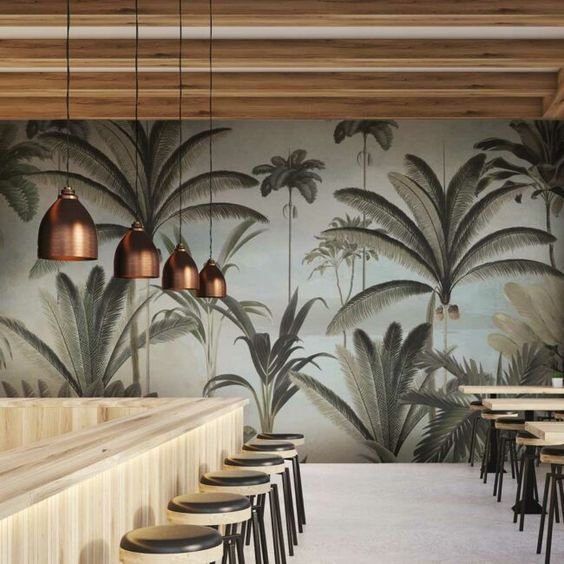
Ideas:
- Texture play: Experiment with materials like reclaimed wood, stone, or textured wallpaper for depth.
- Brand colors: Use the accent wall to highlight your brand colors or thematic hues.
- Photo murals: Install large-scale photo murals depicting scenes relevant to your restaurant’s story.
- Interactive elements: Incorporate interactive features like digital art installations or kinetic sculptures.
- Seasonal themes: Change accent wall decor seasonally to reflect holidays or local festivities.
Best Practices:
- Thematic alignment: Ensure accent wall design aligns with your restaurant’s concept and menu.
- Quality materials: Invest in durable materials that withstand wear and tear in a restaurant environment.
- Staff training: Educate staff on the accent wall’s design elements to enhance guest interaction.
- Guest engagement: Encourage guests to share photos of the accent wall on social media platforms.
- Feedback integration: Gather guest feedback on accent wall designs to inform future updates.
5. Creative Lighting
When it comes to interior design decisions, lighting can make a significant difference to the overall look and feel of a restaurant.
Lighting can be used to create a pleasant ambiance for your guests, highlight focal points in your operations, and set the right tone for your business.

Ideas:
- Layered lighting: Combine ambient, task, and accent lighting to create depth and ambiance.
- Dimmer controls: Install dimmers to adjust lighting levels based on time of day or event type.
- Lighting fixtures: Choose statement fixtures that complement your restaurant’s theme and decor.
- Natural light: Maximize natural light during daytime hours to create a warm and inviting atmosphere.
- Highlight features: Use spotlights or directed lighting to emphasize artwork, plants, or architectural elements.
Best Practices:
- Energy efficiency: Choose LED or energy-efficient lighting options to reduce operational costs.
- Lighting zones: Create lighting zones to adjust ambiance based on different dining areas or times of day.
- Regular maintenance: Schedule routine checks to replace bulbs and clean fixtures for optimal performance.
- Guest comfort: Use lighting to create a comfortable dining experience without glare or shadows.
- Consult professionals: Seek advice from lighting designers to achieve desired effects and efficiency.
6. Highlight the Kitchen
Incorporate an open commercial kitchen layout into your restaurant interior design to make the kitchen the heartbeat of any restaurant.
Your guests will see how delicious the dishes are as they are being prepared, adding to the atmosphere and making their mouths water.
This is also applicable to cafeteria interior design where you show ASMR coffee making to keep people engaging!
Especially if you have a unique focal point like a wood-burning oven for pizza, make the kitchen part of the decor.
If opening the kitchen isn’t possible, consider using an exposed wine cellar, whiskey tunnel, or another unique space to offer guests a glimpse of the back of the house (BOH).
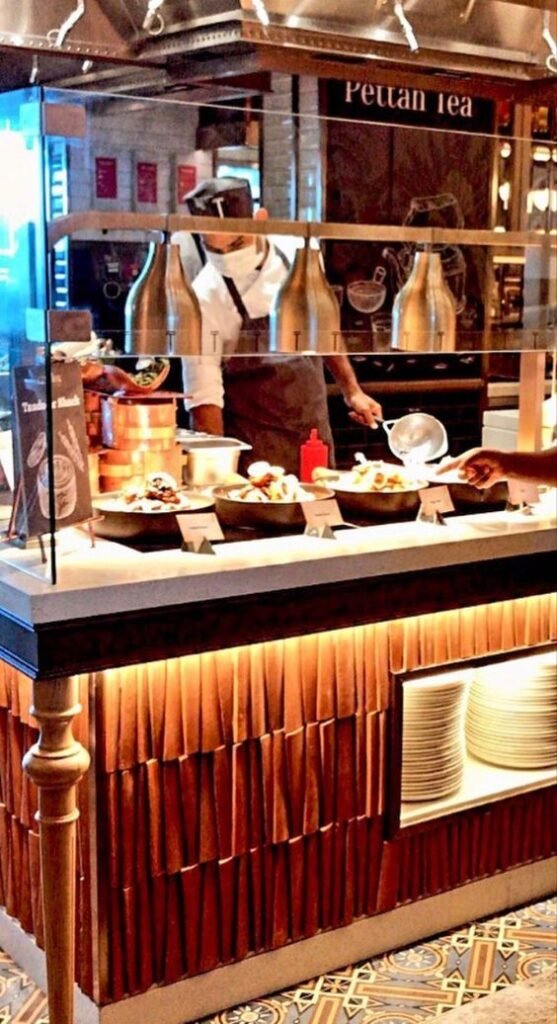
Ideas:
- Open Kitchen Layout: Incorporate a fully visible kitchen where guests can see chefs preparing meals.
- Unique Focal Point: Highlight a special feature like a wood-burning oven or a sushi bar.
- Exposed Wine Cellar: Use a visible wine cellar or whiskey tunnel as a unique showcase.
- Interactive Cooking Stations: Introduce interactive cooking stations where guests can customize their dishes.
- Chef’s Table Experience: Offer a chef’s table where guests can dine right amid the kitchen action.
Best Practices:
- Cleanliness and Organization: Ensure the kitchen is immaculately clean and well-organized at all times.
- Safety and Hygiene: Maintain strict standards of hygiene and safety visible to guests.
- Engaging Staff: Train kitchen staff to interact positively with guests who observe them.
- Transparent Processes: Keep processes transparent; guests should understand what they’re seeing.
- Enhanced Lighting: Use appropriate lighting to highlight the kitchen without overwhelming the dining area.
7. Emphasize Communal Dining
As a result of the COVID-19 pandemic, your guests are seeking more connection than ever before.
Your guests will love creating new memories in your restaurant if you set up a few long tables in the middle of the room, like at U Barba Osteria in Milan, Italy.
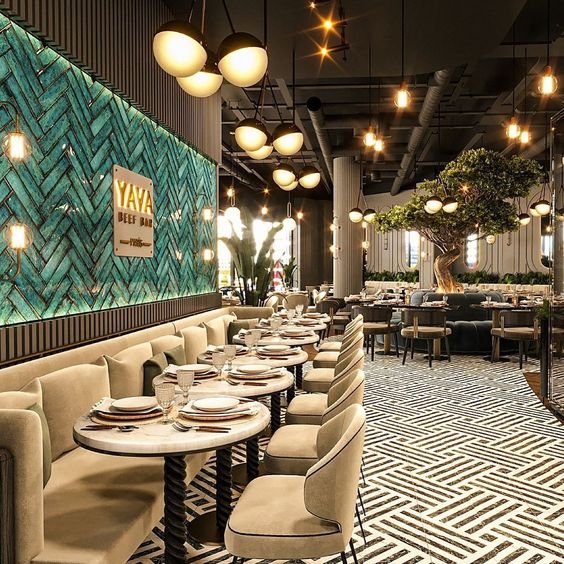
Ideas:
- Long Communal Tables: Install large tables to encourage group dining and interaction.
- Customizable Seating Arrangements: Offer flexible seating arrangements for varying group sizes.
- Community Events: Host community events like food tastings or themed dinners.
- Shared Plates: Serve dishes meant for sharing to encourage interaction among guests.
- Interactive Dining Experiences: Introduce activities or entertainment that encourage conversation.
Best Practices:
- Comfortable Seating: Ensure communal tables are comfortable and spacious enough.
- Privacy Balance: Provide options for both communal and private dining areas.
- Facilitate Conversation: Design the space to minimize noise and enhance conversation.
- Reservations Management: Manage reservations to balance communal and individual dining preferences.
8. Get Creative With Seating
In the restaurant industry today, booths and four-person tables are the most common seating options. It is important to get creative with your seating options when it comes to adding a bit of uniqueness to your establishment. You might consider using stools instead of chairs or using long communal tables instead of smaller, separate ones.
Adding a communal table, removing TVs, or offering board games while guests wait can also create a more community-centered atmosphere in your restaurant.
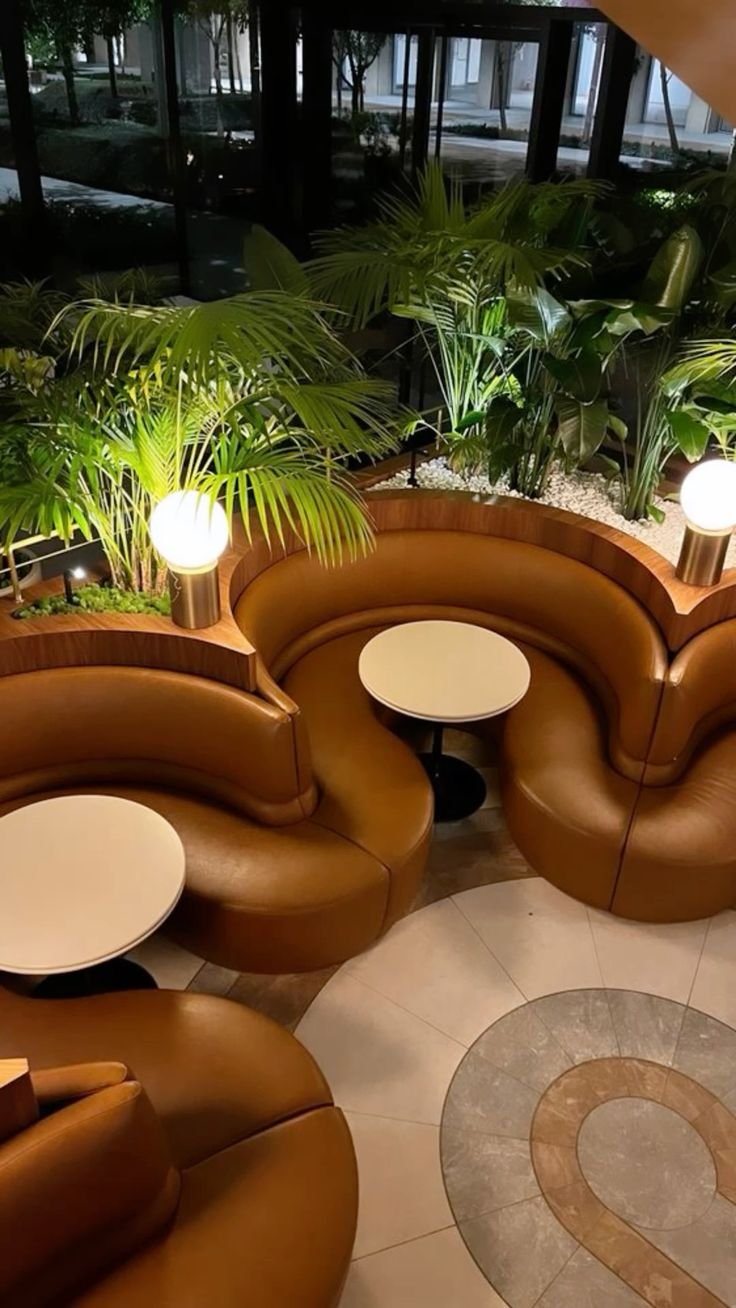
Ideas:
- Stools and High Tables: Opt for stools and high tables for a casual dining experience.
- Outdoor Seating: Create outdoor seating options such as a patio or garden area.
- Flexible Seating Configurations: Allow for easy reconfiguration of seating arrangements.
- Mixing Seating Types: Combine booths, bar seating, and traditional tables for variety.
- Multi-functional Spaces: Design areas that can transition from dining to lounging or events.
Best Practices:
- Comfort and Accessibility: Ensure all seating options are comfortable and accessible.
- Aesthetics and Theme: Match seating designs with the overall theme and decor of the restaurant.
- Traffic Flow: Maintain clear pathways and avoid congested seating arrangements.
- Staff Efficiency: Optimize seating to facilitate efficient service by staff.
- Customer Feedback: Regularly solicit feedback on seating preferences to refine offerings.
9. Minimalistic Decor
Think clean lines, natural materials, and a simple color scheme to create a less-is-more vibe. Keep in mind that every detail matters and will be noticed when you choose a simple approach.
A modern restaurant interior design consists of a lot of white space and sparse color infusions, as seen at Auburn in Los Angeles. Create a low-stimulation environment to allow your guests to focus on their food by keeping things simple.
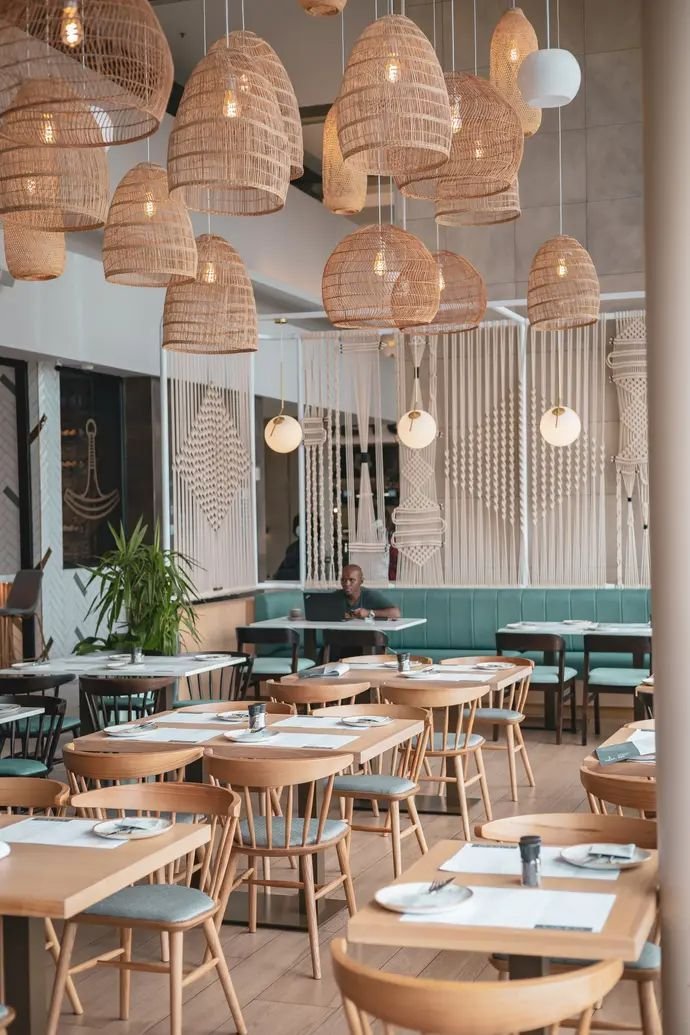
Ideas:
- Natural Materials: Use wood, stone, or metal for furniture and decor elements.
- Neutral Color Palette: Stick to a palette of whites, grays, and earth tones.
- Functional Design: Prioritize functional furniture and minimal ornamentation.
- Indoor Plants: Incorporate indoor plants for a touch of greenery and freshness.
- Subtle Lighting: Use soft, ambient lighting to enhance the minimalist feel.
Best Practices:
- Quality Over Quantity: Select high-quality, durable furnishings and decor pieces.
- Consistency: Maintain consistency in design elements throughout the restaurant.
- Space Optimization: Optimize space usage to avoid clutter and maintain openness.
- Attention to Detail: Focus on small details like textures and finishes for a cohesive look.
- Maintenance Ease: Choose materials and decor that are easy to clean and maintain
10. Incorporate Mirrors
You can use mirrors as a design tactic to create the illusion of depth in your dining room, especially if it is small. In Dubai, United Arab Emirates, Shabeebek incorporates mirrors effortlessly into its restaurant decor.
Mirrors come in virtually every style, so you’re likely to be able to find something that matches your own style.
You can make your restaurant appear larger by using mirrors to reflect the space. In addition, you can dress up a wall by mixing different mirror types and sizes.
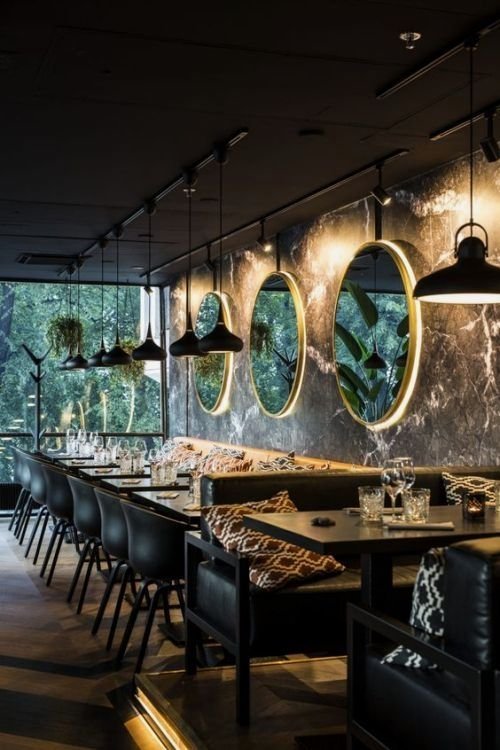
Ideas:
- Illusion of Space: Use mirrors to create the illusion of a larger dining area.
- Reflective Decor: Integrate mirrors into decor items like framed art or partitions.
- Multiple Mirrors: Arrange mirrors in clusters or different shapes for visual interest.
- Functional Mirrors: Use mirrors that serve dual purposes, such as decorative and functional.
- Customized Mirrors: Explore custom designs that complement the restaurant’s style.
Best Practices:
- Placement Strategy: Strategically place mirrors to maximize light reflection and visual impact.
- Size and Scale: Choose mirror sizes that suit the scale of the space and decor.
- Frame Selection: Select frames that enhance the overall aesthetic without overpowering it.
- Regular Maintenance: Keep mirrors clean and free of smudges or streaks.
- Consultation with Designers: Seek advice from interior designers for optimal mirror placement.
Why Cafe Interior Design Is Important?
People from all walks of life come into a cafe. While there is a target audience, it is still fluid and vague. As opposed to restaurants, cafes don’t offer a single ambiance, so people are free to do what they want with their laptops or books.
Coffee accompanies every age group, and simple, affordable meals create an atmosphere for both partying and reading. Therefore, cafe interior design becomes important since it determines the way people feel about the cafe.
From the ambiance to the decor, every element of your cafe contributes to its unique character and influences customers’ perceptions and spending habits. Ultimately, like any business, a cafe aims to increase profits and decrease expenses, which revolves around satisfying the customer.
Feedback surveys have revealed that in the realm of cafes, customers prioritize their overall experience over simply good coffee, highlighting the crucial role of interior design in creating a memorable visit for patrons.
Factors Affecting Your Cafe Design Interior
Would you prefer your customers to have a speedy dining experience or stay longer and order at their leisure? Keep in mind that your interior design can affect how quickly your tables are turned over.
Therefore, it is important to consider this when selecting furniture, as factors such as color, lighting, music, scent, and furnishings can influence the ambiance and encourage customers to either linger or depart.
By offering limited seating options, less-than-ideal chairs, and bold shades such as red or yellow, it can prompt patrons to opt for a quick meal and leave – a step towards creating a QSR atmosphere.
Alternatively, incorporating pastel tones, soothing music, wooden furnishings, or cozy seating choices can encourage customers to linger for extended periods. This type of ambiance is often favored by coffee shops. It’s essential to align coffee shop interior design with your target demographic.

